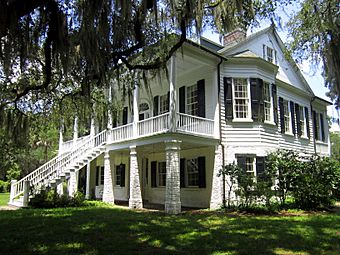Grove Plantation facts for kids
Grove Plantation is a historic house located on Edisto Island, South Carolina. It's a beautiful old plantation house that has seen many changes over hundreds of years. Today, it helps protect wildlife and nature.
Contents
History of Grove Plantation
The land where Grove Plantation stands was first given to Robert Fenwick in 1694. For many years, from 1695 to 1825, the property was bought and sold nine different times.
The Morris Family Years
In 1825, a man named George Washington Morris bought the land. He was the grandson of Lewis Morris, who was famous for signing the United States Declaration of Independence. George Washington Morris named his new property "Grove Plantation."
George Washington Morris was born in 1796 in Morrisania, New York. He married Maria Evans Whaley, who was from Edisto Island. His family already owned a lot of land nearby. Around 1828, he built the main house at Grove Plantation.
The house was built in a style called "Late Federal." It has some unique features, like rooms with many sides and parts that stick out symmetrically. George Washington Morris passed away in 1834. He left behind his wife, Maria, and their four children.
After his death, Maria took charge of Grove Plantation. She was a very strong and smart woman. She even bought a schooner, which is a type of boat, to transport goods for her neighbors. By 1837, she had paid off all her husband's debts. She also had the house plastered, making it look even better. In 1839, she got a threshing machine to help with farming. By 1841, she had a housekeeper and a governess working for her, along with her overseer.
George Jr., the son of George Washington Morris, took over the plantation after his mother. However, he wasn't as good at managing money. He built up a lot of debt before he passed away in 1857.
After George Jr.'s death, the plantation was sold to John Berkely Grimball in 1857. John Grimball was married to Margaret Ann Morris, who was George Washington Morris's niece. He already owned the plantation next door, called Pinebury. He combined Pinebury and Grove Plantation into one large property. His family moved into the Grove House in early 1858.
During the American Civil War, the Grimball family left for Spartanburg. Both Pinebury and Grove Plantation saw military action. The Grove House was even used by Confederate soldiers at one point. Because the Grove was considered abandoned, the government took control of it.
However, on January 24, 1866, John Grimball asked for his property back. He took an oath of loyalty to the United States, which allowed him to get back ownership of both Grove and Pinebury.
After the war, John Grimball found it hard to make his mortgage payments for the Grove. So, in 1870, the land went back to George Washington Morris's heirs. These were Josephine M. Porter and Sabina Ann Morris. Josephine was married to Peter A. Porter, a well-known Colonel from New York who had died during the Civil War.
Later Owners of Grove Plantation
After the Morris family, the property was owned by several different people. In 1929, Owen Winston, who was the president of a famous clothing company called Brooks Brothers, bought it. Winston did a lot of work to restore the house. He probably also added the smaller buildings around the main house.
The plantation changed hands a few more times. In 1930, Thompson Brown bought it. The Brown family used the Grove as a winter vacation home. They enjoyed hunting waterfowl and deer there.
In 1964, R. Carter Henry purchased the Grove. The Henry family did another big renovation of the house. They changed the staircase in the main entrance to an open design. They also added special duck tiles around the fireplace in one of the rooms. They also worked on the other buildings on the property.
Mr. Henry sold the Grove to A. Leigh Baier in the early 1970s. During the Baier family's time, many of the "rice field trunks" were rebuilt or replaced. These are structures that control water in the rice fields. They also fixed many of the dikes, which are walls that hold back water. Mr. Baier then sold the Grove to Margaret B. Hendricks. She owned the plantation until The Nature Conservancy bought it in 1991.
Grove Plantation Today
In 1992, the United States Fish and Wildlife Service bought Grove Plantation. They made it part of the ACE Basin National Wildlife Refuge. The Grove Plantation House is special because it's one of the few old mansions in the ACE Basin area that survived the Civil War.
To make sure it would be protected, former owners had the house placed on the National Register of Historic Places in 1978. This means it's recognized as an important historical site. The house had another major renovation between 1996 and 1997.
Today, the Grove Plantation House is used as the main office for the US Fish and Wildlife Service's ACE Basin National Wildlife Refuge. It's a great example of history being preserved and used to help protect nature.




